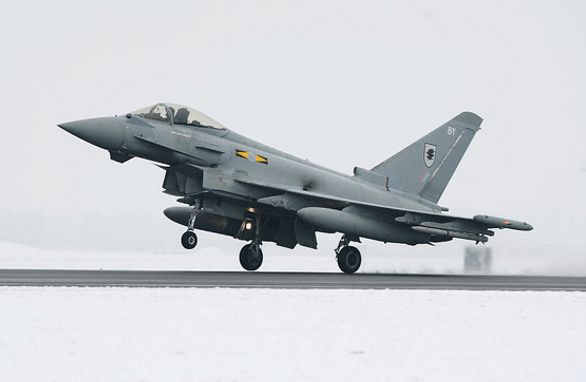Background
If you saw a plane in the sky like the one in the image below and you were not too familiar with aerodynamics, you might think that’s smoke coming out of the jet engines and be concerned.
Figure 1: Wake turbulence from an aircraft [1]
This is actually a well-known phenomenon called wake turbulence. You may have heard the term turbulence if you have ever travelled on an aircraft, or at least felt it as you grip onto the person sitting next to you and mutter your last prayers as you wonder how long it is until you plunge to your inevitable doom. What you feel is the effect of turbulent (chaotic, inconsistent and disrupted) air flow around the aircraft. Aircraft are designed to be able to withstand turbulence and navigate it, and it has become an accepted part of air travel for the most part.
Wake turbulence is slightly different as it is a downstream disturbance that follows behind something as it passes through the air. For aircraft, it generally includes effects from the jet engines and the wingtips and can be commonly seen in certain conditions as trails of air (that might look like smoke to the untrained eye) behind an aircraft. This does not affect the aircraft that is causing the wake, but it can affect the aerodynamics of the aircraft behind, even if it is a few kilometres away. This is why one aircraft can not follow right behind another, and a big part of the reason why there is a significant time between one aircraft departing/landing at a runway and the next one.
A wake is an aerodynamic effect and as such, it can be applied to other things which move in air as well. When you drive a car, you leave a wake behind you. At high speeds this is particularly pronounced and can affect the car behind you (commonly seen in Formula 1 for example, where cars have to avoid staying in the wake of the car in front for too long because it affects their aerodynamic performance).
Wake From Wind Turbines
Wind turbines are not moving forwards in the air like an aircraft or a car so you might think wake effects are not important. However, it is not whether the object is moving in the air or whether the air is moving over the object that is important (wind tunnels model moving objects by blowing air over the object rather than moving the object through the air).
A wind turbine generates electricity from the air arriving in front of it and so the air leaving behind the turbine must have a lower energy content than the air arriving in front. This is because energy cannot be created or destroyed so when some of the energy is converted to electricity, there is a net energy loss from the air. The air behind the blade is therefore slower, and also more turbulent due to the movement of the turbine blades. This is the wake effect which can be seen in the example in Figure 2 below. What this means for wind farms with turbines in rows placed behind each other is that the front row of turbines will always be the most efficient, as downstream turbines lose efficiency due to wake effects. An example wind farm is the Horns Rev 1 wind farm (the first large-scale offshore wind farm in the world) off the coast of Denmark. The downstream wind turbines lose 20-30% of their power relative to the front row [2].
Figure 2: Wind turbine structure [3]
Important Considerations Regarding Wind Turbine Wake
Wind turbine wake is something that both wind turbine designers and wind farm developers need to be very aware of. There are multiple ways in which it is considered, some of which are described below.
- Firstly, the layout of the wind turbines is very important.
- Turbines will generally be spaced apart to account for wake, both perpendicular and parallel to the prevailing wind direction. The further away a turbine is placed behind another, the lower the wake effect experienced.
- As a rule of thumb, turbines are usually spaced between 5-9 rotor diameters apart in the prevailing wind direction and 3-5 rotor diameters in the direction perpendicular to the prevailing winds.
- The more turbines in the park, the more the wake loss, and the greater the overall area required. Considering that rotor diameters can often be 150-250m as standard, these spacings can be really significant and create large space requirements.
- This is one of the reasons why offshore wind farms are so important, because this space requirement is not as much of an issue as for onshore wind farms. The bigger the space needed, the more expensive the land, the more complicated equipment, and the higher the resulting maintenance costs.
- Another solution is to angle the rotor slightly, so it is not perfectly aligned with the incoming wind. This can be used to control the direction of the wake, so that it misses the turbine behind. There are systems which can do this like ‘Wake Adapt’ from Siemens Gamesa.
- Wind turbine designers can design turbine blades to reduce the amount of turbulence they introduce into the flow and reduce wake effects therefore.
About Pager Power
Pager Power has expertise in helping wind developers assess the impacts of both offshore and onshore wind projects upon aviation and telecommunications as well as engaging with stakeholders. For more information about what we do, please get in touch.
References
[1] C. Clarke, “Quiz: Wake Turbulence Avoidance,” 20 April 2020. [Online]. Available: https://studentpilotnews.com/2020/04/20/quiz-wake-turbulence/. [Accessed 20 May 2021].
[2] K. Plaschkes, “Wind Turbine Wake Model,” Yeda Center, [Online]. Available: https://www.youtube.com/watch?v=mzTDvNMEdmY&ab_channel=YedaCenterYedaCenter. [Accessed 20 May 2021].
[3] D. Snieckus, “Will wind-wake slow industry’s ambitions offshore?,” Recharge, 2 November 2019. [Online]. Available: https://www.rechargenews.com/wind/will-wind-wake-slow-industrys-ambitions-offshore-/2-1-699430. [Accessed 20 May 2021].





